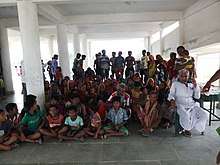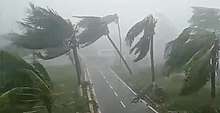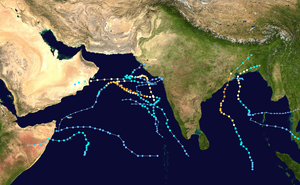Cyclone Fani
Extremely Severe Cyclonic Storm Fani (/ˈfɒniː/)[lower-alpha 1] was the strongest tropical cyclone to strike the Indian state of Odisha since the 1999 Odisha cyclone. The second named storm and the first severe cyclonic storm of the 2019 North Indian Ocean cyclone season, Fani originated from a tropical depression that formed west of Sumatra in the Indian Ocean on 26 April. Vertical wind shear at first hindered the storm's development, but conditions became more favorable for Fani on 30 April. Fani rapidly intensified into an extremely severe cyclonic storm and reached its peak intensity on 2 May with 1-minute sustained winds equivalent to a high-end Category 4 major hurricane. Fani weakened before making its landfall, and its convective structure rapidly degraded thereafter, degenerating into a remnant low on 4 May, and dissipating on the next day.
| Extremely severe cyclonic storm (IMD scale) | |
|---|---|
| Category 4 tropical cyclone (SSHWS) | |
 Cyclone Fani at peak intensity on 2 May, while approaching Odisha | |
| Formed | 26 April 2019 |
| Dissipated | 5 May 2019 |
| (Remnant low after 4 May) | |
| Highest winds | 3-minute sustained: 215 km/h (130 mph) 1-minute sustained: 250 km/h (155 mph) |
| Lowest pressure | 932 hPa (mbar); 27.52 inHg |
| Fatalities | 89 total |
| Damage | $8.1 billion (2019 USD) |
| Areas affected | Odisha, West Bengal, Andhra Pradesh, East India, Bangladesh, Bhutan, Sri Lanka |
| Part of the 2019 North Indian Ocean cyclone season | |
Prior to Fani's landfall, authorities in India and Bangladesh moved at least a million people each from areas within Fani's projected path onto higher ground, and into cyclone shelters, which is thought to have reduced the resultant death toll and casualties.[3] Fani killed at least 89 people in eastern India and Bangladesh and caused about US$8.1 billion in damages in both India and Bangladesh, mostly in Odisha, in India.[4]
Meteorological history

The IMD began tracking a depression located to the west of Sumatra on 26 April, classifying it as BOB 02. Later that day, the Joint Typhoon Warning Center (JTWC) issued a Tropical Cyclone Formation Alert on the system.[5] Afterward, the storm slowly coalesced while moving northward, and was upgraded to a deep depression at 00:00 UTC on 27 April.[6] At the same time, the JTWC began warning on the system, designating it 01B.[7] Six hours later, the IMD upgraded the system to a cyclonic storm and gave it the name Fani.[8]
The system continued to intensify until 18:00 UTC on 27 April, after which it stagnated for over a day, as convection around the storm's center waxed and waned.[9] Fani resumed strengthening around 12:00 UTC, with the IMD upgrading it to a severe cyclonic storm.[10] At that time, Fani began a period of rapid intensification as it was located within a very favorable environment with sea surface temperatures of 30–31 °C (86–88 °F) and low vertical wind shear. As a result, the JTWC upgraded Fani to a Category 1-equivalent cyclone late on 29 April.[11] Around 00:00 UTC on 30 April, Fani was upgraded to a very severe cyclonic storm by the IMD.[12] The organization of the system continued to improve, with tight spiral banding wrapping into a formative eye feature,[13] resulting in Fani being upgraded to an extremely severe cyclonic storm by the IMD around 12:00 UTC[14] while the JTWC upgraded the storm to a Category 3-equivalent cyclone hours later.[15] Development proceeded more slowly over the following days, with little improvement evident in the system's satellite presentation. On 2 May, however, the central dense overcast became more symmetrical and the eye more distinct, and Fani was upgraded to a Category 4-equivalent cyclone by the JTWC at 06:00 UTC.[16] Shortly after, Fani started another period of rapid intensification, attaining 1-minute sustained winds of 250 km/h (155 mph) just below Category 5-equivalent tropical cyclone intensity, according to the JTWC.[17] At 8:00 a.m. IST (02:30 UTC) 3 May, Fani made landfall near Puri, Odisha as an extremely severe cyclonic storm, with 3-minute sustained winds of 185 km/h (115 mph).[18] This made Fani the most intense storm to make landfall in India's Odisha state since the 1999 Odisha cyclone.[19] Land interaction quickly degraded Fani's convective structure; and it weakened to a Category 1-equivalent tropical cyclone soon after landfall.[20] Fani continued to weaken after landfall, weakening to a cyclonic storm later that day,[21] before passing just north of Kolkata. On 4 May, Fani weakened to a deep depression and moved into Bangladesh,[22] before degenerating into a well-marked low later on the same day.[23] On 5 May, Fani's remnant low dissipated over Bhutan.
Preparations

The India Meteorological Department tracked the storm and issued numerous yellow warnings for much of the south-eastern portion of India when the cyclone started to intensify.[24][25] In preparation for the storm's impact, the state government of Odisha and its agency OSDMA evacuated over 1.2 million residents from vulnerable coastal areas and moved them to higher ground and into cyclone shelters built a few kilometres inland. The authorities deployed around a thousand emergency workers and 43,000 volunteers in these efforts. It sent out 2.6 million text messages to warn of the storm in addition to using television, sirens and public-address systems to communicate the message. About 7,000 kitchens were operated to feed evacuees in 9,000 storm shelters.[26][27]
The Indian Navy readied naval ships and aircraft at Arakkonam and Visakhapatnam air-bases to prepare for the storm's aftermath and aid in reconnaissance, rescue and relief operations.[28] The Odisha government staged "300 power boats, two helicopters and many chain saws, to cut downed trees" for the purpose.[27]
Authorities in Bangladesh were ordered to open shelter areas as well in 19 coastal districts.[29] Bangladesh Navy deployed 32 naval ships to provide emergency relief and medical assistance to the coastal areas in case of any emergencies.[30] More than 1.2 million people were evacuated in Bangladesh and moved to the cyclone shelters in coastal areas.[31]
Impact and aftermath
India
Odisha
Approximately 72 people have been killed by Fani in India; 64 in Odisha,[32] In Odisha, a teenager was killed after being hit by a falling tree. One woman died when she was hit by flying debris, and another died of a heart attack while in a cyclone shelter.[33] The cyclone adversely affected electricity supply and telecommunication in several coastal areas of Odisha, and to a lesser extent, of West Bengal. Puri and Khordha district in Odisha were the worst hit.[26] The Jagannath Temple in Puri suffered minor damage, the repairing cost were estimated to be ₹51 million (US$738,000).[34] The KIIT University also suffered a damage of about ₹300 million (US$4.3 million).[35] Total damage in Odisha were estimated at ₹120 billion (US$1.74 billion), mostly in property damage and the relief.[36] After the cyclone, Odisha required ₹170 billion (US$2.46 billion) for rebuilding the infrastructure.[37] Indian Prime Minister Narendra Modi announced that the government had released over ₹10 billion (US$145 million) for the states affected by Fani.[38] There were massive environmental devastation, as well.[39]

Although no fatalities occurred in Andhra Pradesh, Srikakulam and Vizianagaram districts reported an economic loss of ₹586.2 million (US$8.5 million).[40] The South Central Railway also suffered a damage of about ₹29.8 million (US$432,000).[41]
.
Bangladesh
Fani killed 17 people in ten districts of Bangladesh.[42] In Bagerhat District, a woman died after being hit by a falling tree, and 7 of them were killed by lightning in two districts of Bangladesh.[43][44] The cyclone also destroyed about 63,000 ha (160,000 acres) of farmland in 35 districts of the country, the agricultural loss were at ৳385 million (US$4.6 million).[45] Total damage in Bangladesh were up to ৳5.37 billion (US$63.6 million).[46]
The Bangladeshi government distributed rice, dried food, and ৳19.7 million (US$234,000) to those affected by the cyclone.[47]
See also
- 1999 Odisha cyclone - the strongest cyclone on record to strike Odisha, also the most intense storm recorded in the North Indian Ocean, which killed over 10,000 people
- Cyclone Viyaru - took a similar path and affected Bangladesh and Myanmar in 2013
- Cyclone Phailin - a powerful tropical cyclone that struck Odisha in 2013, which displaced over 1 million people
- Cyclone Amphan - a strong powerful Super Cyclonic Storm to affecting similar area
References
- "How Cyclone Fani got its name". Dhaka Tribune. 2 May 2019. Retrieved 2 May 2019.
- ঘূর্ণিঝড়ের ফণী নামটি কোথা থেকে এলো? (in Bengali). BBC Bangla. 30 April 2019. Retrieved 2 May 2019.
- Kumar, Hari; Gettleman, Jeffrey; Yasir, Sameer (4 May 2019). "'The Worst Is Over': A Sigh of Relief in India, Mostly Spared by Cyclone". The New York Times. Retrieved 5 May 2019.
- "Global Catastrophe Recap: First Half of 2019" (PDF). Aon Benfield. Retrieved 12 August 2019.
- Tropical Cyclone Formation Alert. Joint Typhoon Warning Center (Report). Naval Meteorology and Oceanography Command. 26 April 2019. Archived from the original on 30 April 2019. Retrieved 30 April 2019.
- TC Advisory 1. India Meteorological Department (Report). 27 April 2019. Archived from the original on 30 April 2019. Retrieved 30 April 2019.
- Tropical Cyclone 01B Warning 001. Joint Typhoon Warning Center (Report). Naval Meteorology and Oceanography Command. 27 April 2019. Archived from the original on 30 April 2019. Retrieved 30 April 2019.
- TC Advisory 2. India Meteorological Department (Report). 27 April 2019. Archived from the original on 30 April 2019. Retrieved 30 April 2019.
- TC Advisory 4. India Meteorological Department (Report). 28 April 2019. Archived from the original on 30 April 2019. Retrieved 30 April 2019.
- TC Advisory 11. India Meteorological Department (Report). 29 April 2019. Archived from the original on 30 April 2019. Retrieved 30 April 2019.
- Tropical Cyclone 01B (Fani) Warning 012. Joint Typhoon Warning Center (Report). Naval Meteorology and Oceanography Command. 29 April 2019. Archived from the original on 30 April 2019. Retrieved 30 April 2019.
- TC Advisory 13. India Meteorological Department (Report). 30 April 2019. Archived from the original on 30 April 2019. Retrieved 30 April 2019.
- Tropical Cyclone 01B (Fani) Warning 015. Joint Typhoon Warning Center (Report). Naval Meteorology and Oceanography Command. 30 April 2019. Archived from the original on 30 April 2019. Retrieved 30 April 2019.
- TC Advisory 15. India Meteorological Department (Report). 30 April 2019. Archived from the original on 30 April 2019. Retrieved 30 April 2019.
- "Tropical Cyclone 01B (Fani) Warning 016". Joint Typhoon Warning Center. Naval Meteorology and Oceanoraphy Command. 30 April 2019. Archived from the original on 30 April 2019. Retrieved 30 April 2019.
- "Tropical Cyclone 01B (Fani) Warning 022". Joint Typhoon Warning Center. 2 May 2019. Archived from the original on 2 May 2019. Retrieved 2 May 2019.
- "Tropical Cyclone 01B (Fani) Warning 023". Joint Typhoon Warning Center. 2 May 2019. Archived from the original on 2 May 2019. Retrieved 2 May 2019.
- "Cyclone Fani makes landfall in India". Deutsche Welle. 3 May 2019. Retrieved 3 May 2019.
- "Tropical Cyclone Fani Slams India's Odisha State, Its Strongest Landfall Since 1999". weather.com. The Weather Company. 3 May 2019. Retrieved 27 May 2019.
- Tropical Cyclone 01B (Fani) Warning 027. Joint Typhoon Warning Center (Report). Naval Meteorology and Oceanography Command. 3 May 2019. Archived from the original on 4 May 2019. Retrieved 4 May 2019.
- TC Advisory 28. India Meteorological Department (Report). 3 May 2019. Archived from the original on 4 May 2019. Retrieved 4 May 2019.
- TC Advisory 30. India Meteorological Department (Report). Archived from the original on 4 May 2019. Retrieved 4 May 2019.
- Bulletin 65 (PDF). India Meteorological Department (Report). 4 May 2019. Archived from the original (PDF) on 4 May 2019. Retrieved 4 May 2019.
- "Cyclone Fani churns toward India, prompting evacuation of almost 1 million". CBS News. AFP. 3 May 2019. Retrieved 3 April 2019.
- Wright, Pam (2 May 2019). "Tropical Cyclone Fani Nears India as Country Works to Evacuate Hundreds of Thousands". The Weather Channel. Retrieved 2 May 2019.
- Mohanty, Debabrata; Bhattacharya, Snigdhendu (4 May 2019). "Fani leaves trail of devastation; India, Bangladesh count losses". Hindustan Times. Retrieved 5 May 2019.
- Kumar, Hari; Gettleman, Jeffrey; Yasir, Sameer (3 May 2019). "How Do You Save a Million People From a Cyclone? Ask a Poor State in India". The New York Times. Retrieved 5 May 2019.
- "Cyclone Fani: Naval ships, aircraft on standby". The Hindu. 30 April 2019. Retrieved 30 April 2019.
- "Bangladesh prepares for Fani as cyclonic storm draws near". Dhaka Tribune. 1 May 2019. Retrieved 1 May 2019.
- "Bangladesh Navy prepared to face Fani with 32 ships". Dhaka Tribune. 4 May 2019. Retrieved 4 May 2019.
- "12 lakh moved to shelters". The Daily Star. 4 May 2019. Retrieved 4 May 2019.
- Ahmad, Adil. "India: Death toll from cyclone Fani climbs to 64". AA.com. Retrieved 12 May 2019.
- "Cyclone Fani kills at least 15 as it moves to Bangladesh". Khaleej Times. Associated Press. 5 May 2019. Retrieved 5 May 2019.
- Jena, Suryakant (8 May 2019). "Srimandir Loss During Cyclone Fani Pegged At 5.1 Crore". Odisha TV. Retrieved 8 May 2019.
- "Cyclone Fani: SOA university faces damage of Rs 30 crore". The New Indian Express. 11 May 2019. Retrieved 11 May 2019.
- "Odisha estimates loss at ₹12,000 Cr due to cyclone Fani". The Hindu Business Line. 15 May 2019. Retrieved 15 May 2019.
- Nanda, Prashant K. (7 May 2019). "Cyclone Fani-ravaged Odisha seeks ₹17,000 crore central assistance". Livemint. Retrieved 8 May 2019.
- "Cyclone Fani: Over Rs 1,000 crore released in advance, says PM Modi". DNA India. 3 May 2019. Retrieved 5 May 2019.
- Misra, Yagnya Valkya (2 October 2019). "The environmental devastation of Cyclone Fani". The Caravan. Delhi Press. Retrieved 7 December 2019.
- "Andhra Pradesh pegs loss due to Cyclone Fani at ₹58.62 crore". The Hindu. 5 May 2019. Retrieved 5 May 2019.
- "SCR incurs Rs. 2.98 crore loss due to cyclone Fani". Telangana Today. 11 May 2019. Retrieved 11 May 2019.
- "Cyclone Fani leaves trail of destruction in Bangladesh; 17 dead, several hurt". Northeast Now. 5 May 2019. Retrieved 5 May 2019.
- "Cyclone Fani: 14 killed in 8 districts". Dhaka Tribune. 4 May 2019. Retrieved 4 May 2019.
- "Ahead of Cyclone Fani, 7 killed by lightning in Bangladesh". EastMojo. 4 May 2019. Retrieved 4 May 2019.
- "Fani damaged crops worth Tk 38.5 cr: Agriculture Minister". The Daily Star. 7 May 2019. Retrieved 7 May 2019.
- "Fani storm loss estimated at Tk 536 crore". Banglanews24.com. 9 May 2019. Retrieved 9 May 2019.
- "Fani damages 53,000 acres of cropland, 13,000 houses". The Daily Star. 4 May 2019. Retrieved 5 May 2019.
External links
| Wikimedia Commons has media related to Cyclone Fani. |
- India Meteorological Department
- 01B.FANI from the U.S. Naval Research Laboratory
- ReliefWeb's main page for this event.
